Abstract
Almost 70 years after the surprise discovery of a cache of textile-wrapped relics inside an early 13th-century reliquary bust, the St Eustace head reliquary (accession number 1850,1127.1), four of the textile relic wrappings were analysed by combining multiband imaging and fibre-optic reflectance spectroscopy (FORS), as well as dye analysis by high-pressure liquid chromatography coupled to mass spectrometry (HPLC-MS) and fibre analysis by scanning electron microscopy—energy dispersive X-ray spectroscopy (SEM-EDX). In all cases, the use of silk was confirmed, in line with the idea that these precious textiles were purposefully chosen for reuse in a sacred setting. Additionally, dye analysis was able to point to the possible geographic origins of the textile fragments. For 1850,1127.1.a, a mixture of sappanwood (Biancaea sappan) and flavonoid yellow dyes was commensurate with a Chinese or Central Asian origin. Mediterranean origins were thought likely for 1850,1127.1.c and 1850,1127.1.f, from the mixture of kermes (Kermes vermilio) and cochineal (likely Porphyrophora sp.), found in the mauve band of the former, and the combination of weld (Reseda luteola), madder (Rubia tinctorum) and an indigoid dye found in the latter. Finally, the unusual combination of sappanwood, orchil and a yellow dye containing flavonoid glucuronides suggested a less straightforward origin for textile 1850,1127.1.g. The other textile fragments from the reliquary were only investigated using FORS without removing them from their Perspex glass mounts. Nonetheless, indications for the presence of insect-red anthraquinone dyes, safflower (Carthamus tinctorius) and an indigoid dye were obtained from some of these fragments. The study provides a window into the landscape of availability, use and re-use in sacred contexts of precious textiles in the 13th century and evidences the geographic reach of these silks, allowing a new perspective on the St Eustace head reliquary.
1. Introduction
The St Eustace head reliquary (accession number 1850,1127.1, Figure 1) is one of the most famous faces in the British Museum collection [1,2,3,4,5,6]. Originally part of the medieval Treasury of Basel Minster, the composition of its metalwork and gemstones [7] has long fascinated scholars. Recent research has set out to explore a less well-studied aspect of the shrine and uncover its inner secrets.
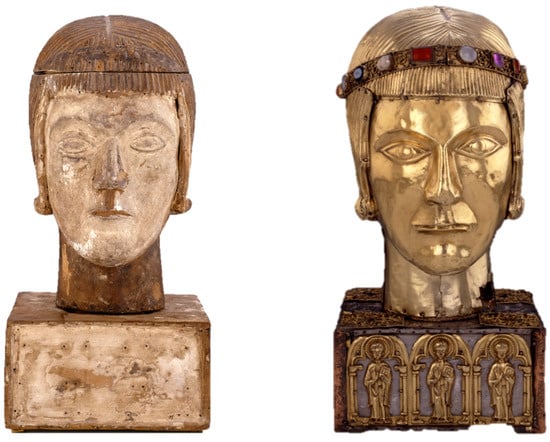
Figure 1.
The St Eustace Head Reliquary (accession number 1850,1127.1)—(left): wooden core, 1180–1200; (right): silver-gilt cover, 1200–1220. © The Trustees of the British Museum.
Dating from the late twelfth to early thirteenth centuries, the reliquary is formed of two principal parts. The first is a wooden bust, made of sycamore or plane (Acer sp.) [8], in the shape of a young man’s head on a square base with remains of gesso, possibly indicating that it was originally painted. Second is a series of silver-gilt sheets made to cover the wooden core, which present a more detailed, expressive version of the same man, wearing a gem and glass-set diadem (Figure 1) and placed on a base decorated with apostles. The wooden portion is thought to date to the final decades of the 1100s and its golden metal covering from the early 1200s. Adding later embellishment to medieval reliquaries was a common practice, and it may be that the addition of the silver-gilt overlay was part of a series of works to update pieces in the Treasury, or it could have been individually financed by a devoted patron. Another possibility is that the creation of the precious metal casing may have resulted from Basel Minster’s receipt of new relics. One potential source of relics, as has been posited by Cherry and Burckhardt, was those brought back from the Fourth Crusade by Martin Abbot of Pairis Abbey, a Cistercian monastery in Alsace [2,6]. The Abbey was in the diocese of Basel and Abbot Martin had close connections with the city. He preached of the Crusade in Basel in May 1200, departed for the Crusade from the city several years later and in 1205 travelled via Basel on his journey back to Pairis from the Holy Land, bringing with him a significant quantity of relics [9]. As Gunther of Pairis recounted in Historia Constantinopliana, his account of Abbot Martin’s participation in the Fourth Crusade, the latter gave an altar covering to the Church of the Blessed Virgin in Basel and ‘He also liberally distributed personal offerings to the city’s bishop, Lord Luthold, and to certain other persons and churches of this same locality [10]’. Might he have presented some of his gathered relics to the bishop or the Minster, prompting the addition of a new gilded shell to the reliquary bust?
The bust’s association with Saint Eustace and location in the Minster is recorded as early as 1477, when it featured in the oldest surviving Treasury inventory, described as ‘Item caput sancti Eustachii’ [2]. It remained part of the Treasury until 1833, when the canton of Basel divided into Basel-City and Basel-Country. In accordance with this separation, Basel’s assets needed to be divided between the two new cantons, including the contents of the Treasury, which in 1827 had been moved from the Cathedral to the Town Hall. In 1834, the St Eustace reliquary was assigned to Basel-Country, and in 1836, it was sold at auction, passing through several hands before its purchase by the British Museum in 1850 [6]. An admired addition to the collection, it was listed as one of the ‘principal acquisitions during the year’ by the Daily News on 22 April 1851 in an article titled ‘Novelties in the British Museum’ [11].
Subsequent guides to the galleries highlighted the reliquary as one of the more notable medieval objects on show, and until the 1950s, the gilded bust was exhibited as a single object. By this time, conservators had noticed signs of corrosion to the metal, and so in spring 1956, they removed the panels for cleaning. On discovering the wooden doppelgänger of Eustace within, staff were further surprised when they lifted off the top of his cranium and found relics and bundles contained inside, including eleven wrapped in a variety of textiles (Figure 2a,b), perhaps uncovered for the first time since their original deposition. Rupert Bruce-Mitford, Keeper of the Department of British and Medieval Antiquities, relayed the news to the museum’s Director on 11 April 1956, writing, ‘I do not know whether you know of the exciting discoveries we have been making with this head in the last few weeks’ [8]. The relics themselves were returned to the Roman Catholic Diocese of Basel in Solothurn; however, the textile wrappings (accession numbers 1850,1127.1.a–k) remained in the collection and are little-studied. They were first listed and preliminarily identified by Muthesius in 1980, who summarised the group and concluded that, ‘These fabrics can certainly be dated before the thirteenth century’ [12]. Unpublished studies carried out in the late 1980s/early 1990s revealed that a number of these were likely of Far Eastern or Central Asian origin, with several possibly dating to 400 years or more prior to the construction of the head [13]. Limited dye analysis at this time partially corroborated this assessment [14,15], but any subsequent analysis was hindered by the mounts that the textiles were then housed in to enable their display. In summary, in ammonia tests for the presence of safflower, pink/beige fibres from 1850,1127.1.a, g, h and k were found not to contain safflower [14], whereas a sample from 1850,1127.1.j gave a positive result for its presence. In the same campaign, ultra-violet visible spectrophotometry identified carminic acid in a red sample from 1850,1127.1.b, and alizarin and indigotin in red and green samples from 1850,1127.1.f, suggesting the presence of cochineal, madder and indigo, respectively [14]. In subsequent analyses, based on a modified extraction and analysis of the extracts using ultra-violet visible spectrophotometry, it was concluded that kermes, orchil and safflower were present in samples from 1850,1127.1.b, g and j, respectively [15].
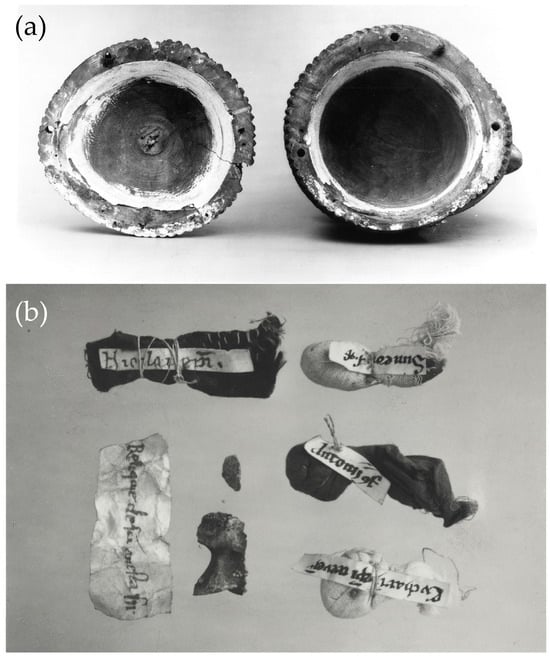
Figure 2.
(a) The interior of the wooden bust of the St Eustace Head Reliquary, 1850,1127.1, with the top of the cranium on the left and the core on the right. Photographed following discovery of the inner bust in 1956. (b) One of the layers of relic bundles from the St Eustace Head Reliquary, photographed after their discovery and removal in 1956, showing bundles 1850,1127.1.b,d,h and f. © The Trustees of the British Museum.
As a result of the 1956 discovery, the wooden head was not re-covered by the silver-gilt overlay, and since this time, the two busts have been exhibited side by side. However, the textiles are rarely displayed, owing to their fragility. Their current Perspex glass (polymethyl methacrylate—PMMA) mounts date from 2000, when the fragments were prepared for loan to an exhibition on the Basel Treasury at the Historisches Museum Basel and the Metropolitan Museum of Art, New York [3,6]. The inclusion of the four earliest fragments (accession numbers 1850,1127.1.a, c, f and g, Figure 3) in the British Museum ‘Silk Roads’ exhibition (26 September 2024–23 February 2025) provided the opportunity to remove these textiles from their mounts and return to the question of where they originated from [16].
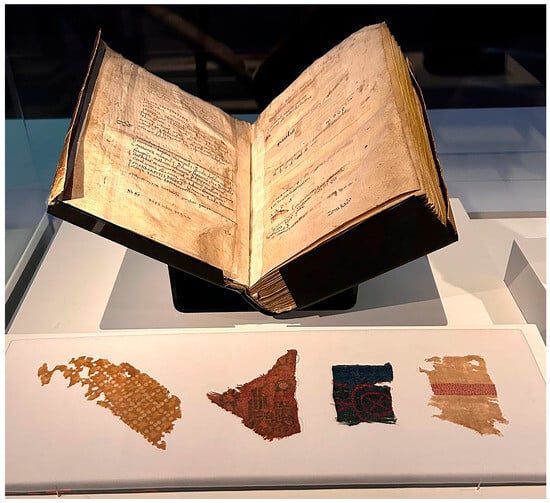
Figure 3.
Fragments of relic wrappings on display at the British Museum ‘Silk Roads’ exhibition (26 September 2024–23 February 2025). From left; 1850,1127.1.a, 1850,1127.1.g, 1850,1127.1.f and 1850,1127.1.c. © The Trustees of the British Museum.
This work describes the use of the British Museum’s well-established protocol, combining multiband imaging (MBI) and fibre-optic reflectance spectroscopy (FORS) [17,18,19], as well as dye analysis by high-pressure liquid chromatography coupled to mass spectrometry (HPLC-MS) of selected samples and scanning electron microscopy–energy dispersive X-ray spectroscopy (SEM-EDX), to re-examine these four textiles after more than thirty years. Additionally, the study provided the opportunity to revisit the other fragments in the group (accession numbers 1850,1127.1.b, d, h, j and k) and, although the full protocol could not be applied to these because they remain in their Perspex glass mounts, FORS was nevertheless able to provide some insights into the nature of the dyes present.
The results obtained inform a more thorough re-assessment of these textiles, to reveal the secrets of this time-capsule of textile finds and provide a window into the landscape of availability, use and re-use in sacred contexts of precious textile imports in the thirteenth century.
2. Materials and Methods
2.1. The Textile Fragments
Textile fragments 1850,1127.1.a–d, f, g, h, j and k are described in the Supplementary Materials (Table S1), together with a summary of previously unpublished technical and analytical studies on these [13,14,15]. However, as the focus of this work is on textile fragments 1850,1127.1.a, c, f and g, the main technical details of these four textile fragments are also summarised in the following sections for ease of reference.
2.1.1. Fragment of Resist-Dyed Silk from the Relic Wrapping of St Anastasius (Accession Number 1850,1127.1.a)
The textile is a 11 × 9.5 cm irregularly shaped fragment of silk in buff, yellow and white, with a small repeating design of lozenges (1.8 × 2.0 cm) formed by four dots to each side enclosing spear-head shapes. It is highly faded and shows some damage, particularly in the areas with these white dots. It is thought to be from China or Central Asia and dating to the 7th century. The pattern was created after weaving by application of a resist medium combined with dyeing. The resist was put on as dots and dye applied once. The resist was put on again as the spear-head shapes and dye applied a second time.
2.1.2. Fragment of White Silk Textile with a Mauve Band from the Relic Wrapping of St Benedict (Accession Number 1850,1127.1.c)
The textile is a 7.5 × 5.0 cm roughly rectangular fragment of a simple tabby weave white silk textile, with a 1.1 cm weft-patterned or brocaded tabby weave band in mauve silk. Its production is likely Mediterranean, possibly Italian, dating to the 8th–9th century.
2.1.3. A Fragment of a Twill Silk Textile from the Relic Wrapping of St Nicholas (Accession Number 1850,1127.1.f)
The textile is a 5.5 × 4.5 cm roughly rectangular fragment of twill silk with a design in dark pink/red, green, and yellow on a dark blue background, showing a four-petalled flower inside a dotted circular frame. On one side are parts of the outside of two larger roundels, the frames of which have repeated leaf or petal shapes. Originally thought to be Mediterranean (Byzantine, Near Eastern or Spanish) in origin, dating to the 10th–12th century, more recent discussions place its production at the later end of this time frame.
2.1.4. Fragment of Twill Silk Textile from the Relic Wrapping of St Nicholas of Myra (Accession Number 1850,1127.1.g)
The textile is 9 × 6.5 cm roughly triangular fragment of twill silk with a design in mid green, outlined in dark yellow or white, on a salmon pink ground. The upper part of a right-facing crested bird with an upwards pointing tail, presumably a peacock, and part of a roundel frame of repeating heart-shaped petals can be observed. The whole roundel would probably have been c.13 cm across. From the bird’s position in relation to the roundel frame, it would have likely been one of a symmetrical pair. Stylistically, the textile is reminiscent of Central Asian examples dating to the 7th century.
2.2. Methodology
A well-established multi-analytical protocol [17,18,19] was applied in order to provide a better understanding of the textile fragments 1850,1127.1.a, c, f and g. Given the size of the fragments, the main aim was to collect as much information non-invasively as possible, using available techniques to minimise the number of micro-samples to be taken for further analysis. As such, the fragments were first investigated using multiband imaging (MBI), a set of broadband photographic methods specifically adapted to map the photoluminescence and reflective characteristics of surfaces under different wavelengths of light. When conducted using standardised acquisition and post-processing methods, these images provide information about the chemical nature of the materials present and their spatial distribution [20], guiding more targeted and effective sampling strategies. This was followed by fibre optic reflectance spectroscopy (FORS), which was used in situ to confirm some of the observations made from the multiband imaging and to provide further details of the dyes present.
Selected micro-samples were then taken from each of the fragments. The micro-samples were analysed using scanning electron microscopy—energy dispersive X-ray spectroscopy (SEM-EDX) to characterise the nature of the fibres present. High pressure liquid chromatography—diode array detector—electrospray ionisation—quadrupole—time of flight (HPLC-DAD-ESI-Q-ToF) was then carried out on dye extracts from the samples to provide dye identification at the molecular level.
Additionally, textile fragments 1850,1127.1.b, d, h, j and k were investigated only non-invasively by carrying out FORS through the Perspex glass of the mount opening. MBI was not applicable, as the Perspex glass would affect the quality of the images, hindering their interpretation.
2.2.1. Multiband Imaging (MBI)
All images were taken using a modified Nikon D7000 camera body with a maximum resolution of 4928 × 3264 (16.2 megapixels). The modification consisted of the removal of the inbuilt UV-IR blocking filter to exploit the full sensitivity of the CMOS sensor (c. 300–1000 nm). The lens used was a Nikon AF-S DX NIKKOR 35 mm f/1.8 G. The camera was operated in fully manual mode. A reference greyscale, comprising a set of Lambertian black, grey and white tiles, was placed in the same plane as the object under investigation. In each case, the object was illuminated by two radiation sources symmetrically positioned at approximately 45° with respect to the focal axis of the camera and at about the same height. A filter, or combination of filters, was placed in front of the camera lens in order to select the wavelength range of interest. Combinations of radiation sources and filter(s) enabled five sets of images to be acquired: visible-reflected (VIS), ultraviolet-induced visible luminescence (UVL), infrared-reflected (IRR), ultraviolet-reflected (UVR) and visible-induced infrared luminescence (VIL) images.
Post-processing procedures for the standardisation and calibration of the VIS, IRR, UVL and UVR images and the creation of infrared-reflected false colour (IRRFC) and ultraviolet-reflected false colour (UVRFC) images were then carried out using “BM_workspace”, a plug-in for Nip2, the open-source graphical user-interface of VIPS, a free image processing software. Further details of the experimental setup, as well as the acquisition and post-processing protocols adopted, are reported in [17,20].
2.2.2. Fibre Optic Reflectance Spectroscopy (FORS)
Fibre optic reflectance spectra were recorded with an Avantes (Apeldoorn, The Netherlands) AvaSpec-ULS2048XL-USB2 spectrophotometer equipped with an AvaLight-HAL-S-IND tungsten halogen light source. The detector and light source were connected with a fibre optic bundle to an FCR-7UV200-2-1.5 × 100 probe. In this configuration, light was sent and retrieved by the bundle set at approximately 45° from the surface normal, thus excluding specular reflectance. The spectral range of the detector was 200 ± 1160 nm; nevertheless, due to poor blank correction on both extremes of the range, only the range between 350 and 900 nm was considered; as per the features of the monochromator (slit width 50 μm, grating of UA type with 300 lines/mm) and of the detector (2048 pixels), the best spectra resolution was 2.4 nm, calculated as full width at half maximum (FWHM). Spectra were referenced against the WS-2 reference tile provided by Avantes. The diameter of the investigated area on the sample was approximately 1 mm, obtained by setting the distance between the probe and sample at 1 mm. The instrumental parameters were as follows: 100 ms integration time and 5 scans, for a total acquisition time of 0.5 s for each spectrum. The whole system was managed using AvaSoft 8 software for Windows.
2.2.3. Scanning Electron Microscopy—Energy Dispersive X-Ray Spectroscopy (SEM-EDX)
Samples were placed uncoated on an adhesive carbon disc mounted onto an aluminium SEM stub. The examination was carried out using a variable pressure VP SEM (Hitachi S-3700N) using the backscatter electron (BSE) detector at 16 kV. The working distance was 10 mm. The SEM chamber was partially evacuated (40 Pa). For fibre identification, an in-house reference collection of known fibres, both in the form of thin sections and raw fibres collected from accredited sources of silk, wool and cotton, was used in combination with comparisons with literature data [21,22,23,24].
The EDX spectra were collected using an Oxford Instruments AZtec EDX spectrometer with a 0 ± 20 KeV spectral range, 150 s of live time and 2048 channels. AZtecEnergy analysis software v.5.1 (Oxford Instruments, Abingdon, UK) was used to process the data.
2.2.4. High Pressure Liquid Chromatography—Diode Array Detector—Electrospray Ionisation—Quadrupole—Time of Flight (HPLC-DAD-ESI-Q-ToF)
The dye extraction was performed using a double mild extraction procedure, using dimethylsulphoxide (DMSO) first and, secondly, a mixture of methanol/acetone/water/0.5 M oxalic acid 30:30:40:1 (v/v/v/v). Additional details are available in [17,25].
The instrumentation consisted of a 1260 Infinity HPLC (Agilent Technologies, Santa Clara, CA, USA), coupled to a 1100 DAD detector (Hewlett-Packard, Palo Alto, CA, USA) and to a Quadrupole-Time of Flight tandem mass spectrometer 6530 Q-ToF detector (Agilent Technologies) by a Jet Stream ESI interface (Agilent Technologies). Separation was achieved using a Zorbax Extend-C18 column (2.1 mm × 50 mm, 1.8 μm particle size) with a 0.4 mL/min flow rate, 40 °C column temperature and a gradient of water with 0.1% formic acid (eluent A) and acetonitrile with 0.1% formic acid (eluent B). The elution gradient was programmed as follows: initial conditions of 95% A, followed by a linear gradient to 100% B over 10 min, held for 2 min. The re-equilibration time for each analysis was 10 min. A 5 μL injection volume was adopted for MS experiments and 10 μL for MS/MS experiments.
The DAD detector (cell volume 50 µL) scanned in the range of 190–700 nm with a 2 nm resolution. The ESI operating conditions were drying gas (N2, purity > 98%) temperature 350 °C and 10 L/min flow; capillary voltage 4.0 kV; nebulizer gas pressure 40 psig; sheath gas (N2, purity > 98%) temperature 375 °C and flow 11 L/min. High resolution MS and MS/MS spectra were acquired in both negative and positive mode in the range 100–1700 m/z. The fragmentor was kept at 100 V, nozzle voltage 1000 V, skimmer 65 V, octapole RF 750 V. For the MS/MS experiments, different voltages (from 10 to 50 V) in the collision cell were tested for Collision Induced Dissociation (CID), in order to maximise the information obtained from the fragmentation of the single molecules. The collision gas was N2 (purity 99.999%). The data were collected through targeted MS/MS acquisition, with an MS scan rate of 1.0 spectra/s and a MS/MS scan rate of 1.0 spectra/s. Auto-calibration was performed daily using Agilent tuning mix HP0321 (Agilent Technologies) prepared in 90% water–10% acetonitrile.
MassHunter Workstation Software v.10.0 was used to carry out diode array detector and mass spectrometer control, data acquisition, and data analysis.
Reference samples of dyes were used for identification [25].
3. Results
The results obtained from the analytical protocol applied to the four textiles fragments are summarised in Table 1 and described in detail in the following sections.

Table 1.
Summary of the results obtained for textile fragments 1850,1127.1.a, c, f, and g.
3.1. Textile Fragment 1850,1127.1.a
Multiband imaging (Figure 4) showed the textile to be highly infrared transparent and mostly UV-absorbing except in the areas with the white dots, consistent with undyed areas where the resist was applied. The IRRFC and UVRFC images showed typical responses for yellow to red/brown dyes. Blue luminescence was noted from the white dots (as would befit undyed/lightly-dyed silk [17]), and some slight luminescence from the light yellow spear-head shapes in the UVL and VIVL images, respectively, was evident.
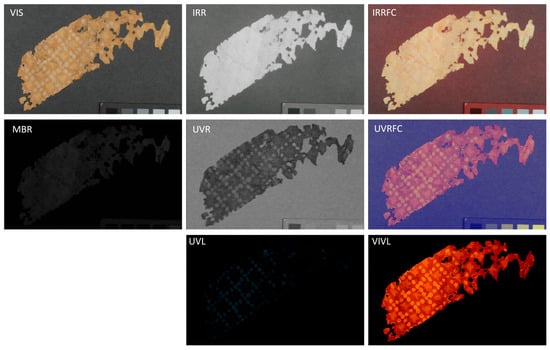
Figure 4.
Multiband images of a fragment of resist-dyed silk from a relic wrapping 1850,1127.1.a. © The Trustees of the British Museum.
No diagnostic spectral features were observed in the data collected with FORS (Figure 5a), as apparent absorption spectra only show an apparent absorption maximum at approximately 400 nm for both buff and light yellow areas, which is typical of most yellow/light brown colourants [5].
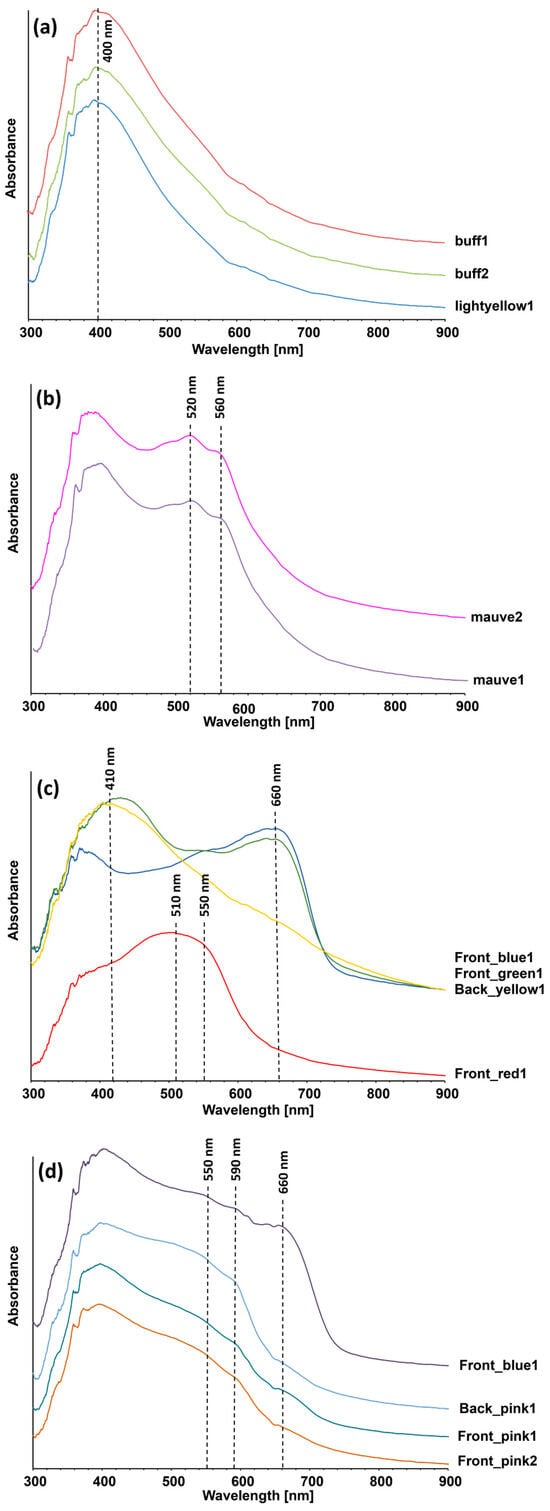
Figure 5.
Apparent absorption spectra of areas of interest from relics wrappings (a) 1850,1127.1.a; (b) 1850,1127.1.c; (c) 1850,1127.1.f and (d) 1850,1127.1.g. © The Trustees of the British Museum.
Due to the fragility of the textile, only one sample was removed for dye analysis, which contained fibres from both coloured areas. Extraction and dye analysis of this sample with HPLC-DAD-ESI-Q-ToF afforded weak signals, which nevertheless revealed the presence of both luteolin-7-O-glucoside and urolithin C (Figure 6). The former is one of the main components of the yellow dye extracted from weld (Reseda luteola) [26,27] but could also be associated with other luteolin-containing (flavonoid) yellow colourants, including the Asian desert poplar (Populus pruinosa) [28,29]. Urolithin C is indicative of the use of the red dye extracted from sappanwood (Biancaea sappan) [30]. It is thus likely that the now buff background was originally much brighter and redder in hue, as sappanwood is known to fade over time to orange-brownish shades [18]. The lozenges may also have been a much brighter yellow.

Figure 6.
Extracted ion chromatograms obtained by HPLC-ESI-QToF analysis of a buff/light yellow sample taken from a fragment of relic wrapping 1850,1127.1.a. © The Trustees of the British Museum.
A small sample of the textile was also taken for fibre identification with SEM-EDX (Figure 7a), which confirmed this to be made of silk. Silk fibres are protein fibres produced by the silkworm (Bombyx mori). Some of the diagnostic features of silk fibres visible in Figure 7a (as well as in Figure 7b,c), include the following:
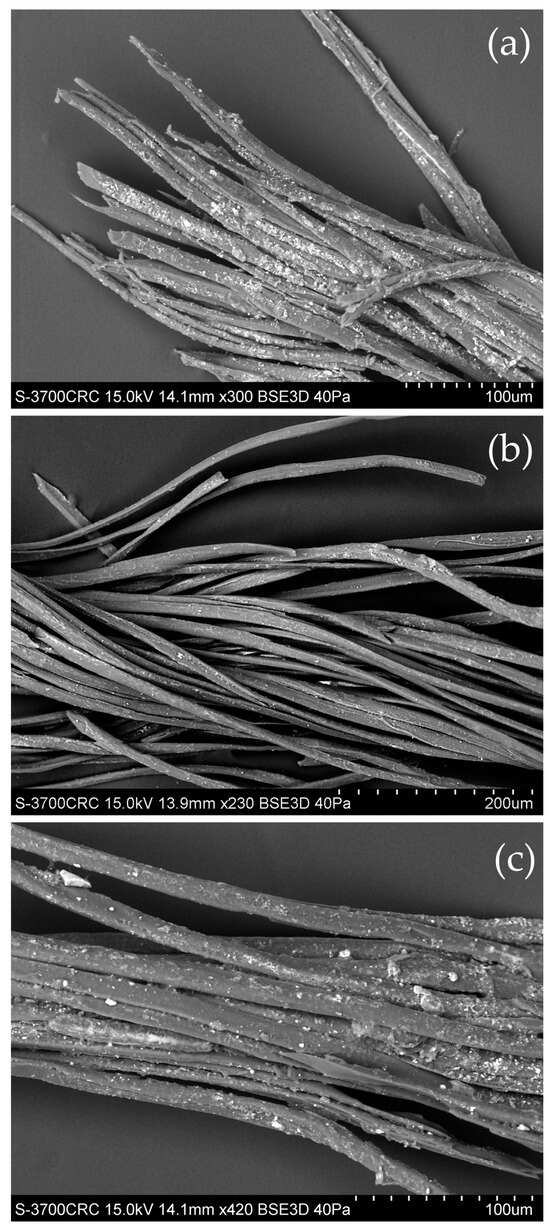
Figure 7.
SEM images of samples of fibres from relic wrappings (a) 1850,1127.1.a; (b) 1850,1127.1.f (warp) and (c) 1850,1127.1.g (warp). © The Trustees of the British Museum.
- Fibres with a smooth texture and flattened cylinder shape, often ribbon-like but with occasional swellings or areas of irregular thickness;
- A triangular or wedge-shaped cross-section to each fibre;
- Fibre ends that are often sharply pointed, bifurcated, angled or have a rounded point;
- Sometimes silk fibres may be in paired form (naturally gummed together).
Comparative reference collection specimens of silk fibres were consulted throughout for verification.
3.2. Textile Fragment 1850,1127.1.c
The textile fragment showed characteristic behaviour for silk in the multiband images acquired (Figure 8), with bluish luminescence observed in the UVL image, and transparency and absorbance in the IRR and UVR images, respectively [17]. Despite the pale shade of mauve observed on the band and the characteristic behaviour in both UVRFC and IRRFC, which might suggest the presence of madder in these areas, no characteristic luminescence in the UVL or VIVL images was observed that would support madder as the colourant used.
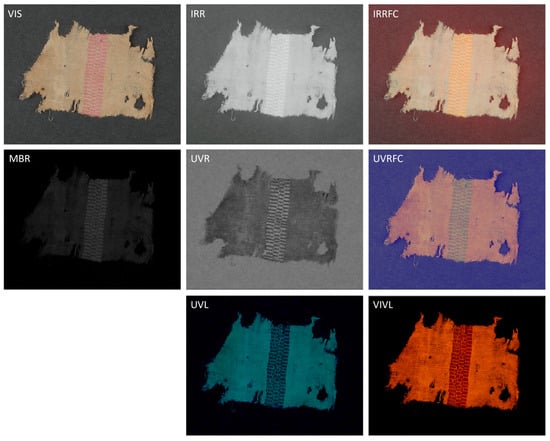
Figure 8.
Multiband images of a fragment of white silk textile with a mauve band from a relic wrapping 1850,1127.1.c. © The Trustees of the British Museum.
Analysis of the mauve areas with FORS suggested the presence of an insect-based anthraquinone dye, as inferred from the bands at c. 520 and c. 560 nm observed in the apparent absorption spectra, Figure 5b.
This was confirmed by dye analysis of a sample from the mauve band, which showed both carminic and kermesic acids to be present (Figure 9). This indicates the use of a mixture of two such insect-based anthraquinone dye sources, cochineal and kermes [31,32]. Interestingly, the so-called dcII minor component of cochineal was not detected, which might suggest the use of Armenian cochineal (Porphyrophora hamelii) [32,33]. Flavokermesic acid, generally found together with kermesic acid in kermes extracts, was also not detected.

Figure 9.
Extracted ion chromatograms obtained by HPLC-ESI-QToF analysis of a sample from a mauve area of relic wrapping 1850,1127.1.c. © The Trustees of the British Museum.
A small sample of the mauve band was also taken for fibre identification Although too small to definitively confirm this to be made of silk, this was strongly suggested upon observation with SEM-EDX, which closely resembled the silk SEM image for 1850,1127.1.f (Figure 7b). An SEM image for 1850,1127.1.c is not included because it was not possible to obtain a satisfactory image, nor was it possible to take a substitute sample to try for an alternative.
3.3. Textile Fragment 1850,1127.1.f
Multiband imaging of the textile fragment (Figure 10) showed that the blue background appeared red in the IRRFC and bright white in the MBR images, which is consistent with the presence of an indigoid dye [17]. The green areas also display behaviour suggesting that an indigoid dye may be present in a mixture (IRRFC appears orange and MBR appears light grey).
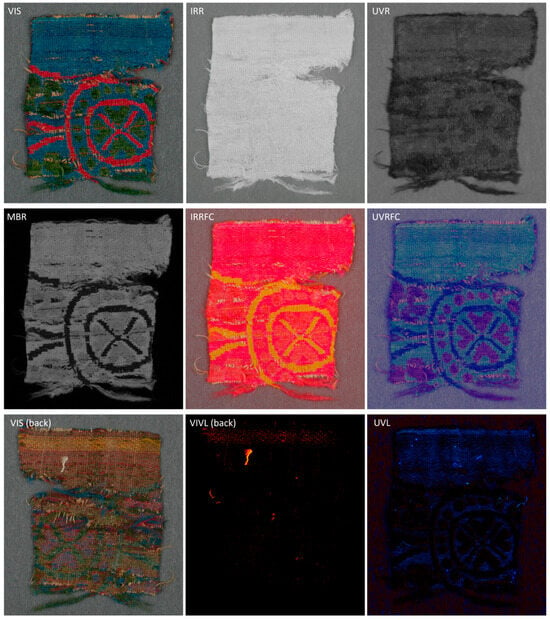
Figure 10.
Multiband images of the front and back (VIS and VIL only) of a fragment of a twill silk textile relic wrapping 1850,1127.1.f. © The Trustees of the British Museum.
Both green and dark pink/red areas were highly absorbing in the UVL images. The red areas additionally showed other characteristic responses, appearing golden yellow in the IRRFC and dark blue in the UVRFC images. The latter suggests that there is very little reflectance in the UV region and that the hue is very purely red with little contribution from green or blue components. From this behaviour, the presence of a very saturated madder dye is likely. The yellow areas can only be clearly seen from the back of the textile and, as the VIVL image shows, these areas display some luminescence.
Diagnostic spectral features were observed in the data collected with FORS, indicating the presence of an indigoid dye in both blue and green areas, as shown by the spectra in Figure 5c. Both areas showed an apparent absorption maximum at approximately 660 nm associated with presence of indigo, with green areas showing an additional maximum at c. 410 nm, as is typical for yellow colourants [17]. A similar response was observed from the yellow areas measured on the back of the textile.
The red areas showed a somewhat featureless absorption at around 500 nm. Bands at c. 510 and c. 540 nm are typical for plant-based anthraquinone dyes, such as madder, but this structure can become less evident when the dye is highly saturated [17].
Dye analysis of samples of yellow and green areas with HPLC-DAD-ESI-Q-ToF revealed the presence of all compounds associated with weld (Reseda luteola), including luteolin, apigenin and chrysoeriol, as well as their glucosides (Figure 11a). Indigotin and indirubin were also detected in the green sample, confirming the use of a blue indigoid dye mixed with weld to obtain this colour.
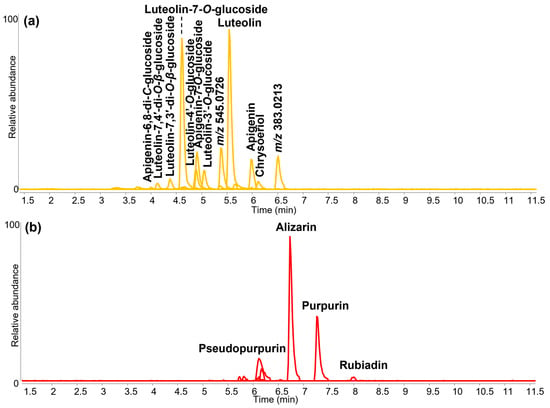
Figure 11.
Extracted ion chromatograms obtained by HPLC-ESI-QToF analysis of samples of (a) yellow and (b) red fibres from relic wrapping 1850,1127.1.f. © The Trustees of the British Museum.
Alizarin, purpurin, pseudopurpurin and rubiadin were detected in the red sample (Figure 11b), indicating the presence of madder, likely Rubia tinctorum [34].
Small samples of both warp and weft fibres (yellow) from the textile fragment were taken for fibre identification with SEM-EDX, which confirmed both to be made of silk Figure 7b.
3.4. Textile Fragment 1850,1127.1.g
Multiband imaging of the textile fragment (Figure 12), in particular the IRRFC and MBR images, showed that areas that appear green/blue are likely to contain indigo as these regions appear red and bright white, respectively, in these images [17]. Additionally, some faint luminescence from a circular feature and the pink background was observed in the UVL and VIVL images of the front of the textile and in two defined bands at the back of the textile.
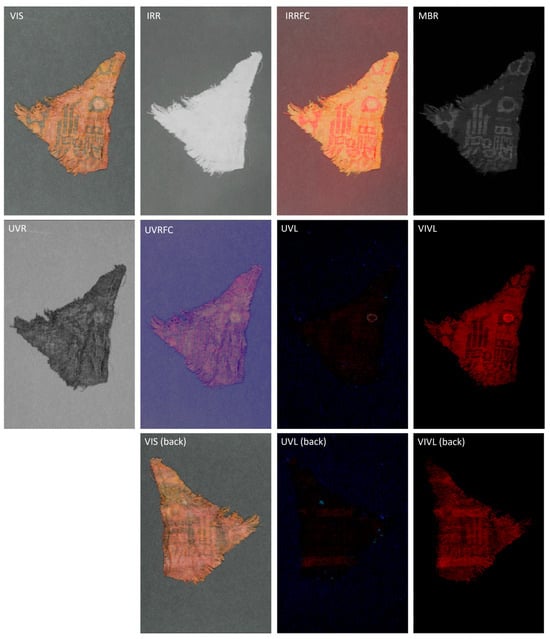
Figure 12.
Multiband images of the front of a fragment of twill silk textile relic wrapping 1850,1127.1.g. © The Trustees of the British Museum.
The nature of the weave (compound weft-faced twill) meant that it was difficult to obtain FORS spectra of isolated coloured areas. As a result, the spectra collected from pink and green/blue areas from the front and back of the textile have some contribution from each other. In general, a clear feature at c. 660 nm was observed in all cases (Figure 5d), as associated with the presence of an indigoid dye, although most prevalent in the spectra from the green/blue areas. Features at c. 550 and c. 590 nm were also observed, which may indicate the presence of orchil in these areas [35].
Dye analysis of samples of yellow and green areas (Figure 13a) revealed the presence of four flavonoids, showing that the same yellow dye was used in these areas. Two of these compounds were identified as kaempferol-O-glucuronide ([M-H]− = 461.0725 m/z) and quercetin-O-glucuronide ([M-H]− = 477.0675 m/z), based on the characteristic loss of the glucuronide unit (176 u) in the tandem mass spectra, revealing the flavonoid aglycone mass as the main fragment ion (Supplementary Materials, Figure S1). A conclusive identification was not possible for the other two molecules. However, the high-resolution mass spectrometry data enabled the chemical formula of these molecules to be disclosed as C23H18O14 ([M-H]− = 517.0624 m/z) and C23H18O15 ([M-H]− = 533.0573 m/z). Glucuronide fragmentation was observed in the tandem mass spectra of these compounds, revealing fragment ions at 341.0292 m/z and 357.0265 m/z, respectively, possibly corresponding to aglycone molecules with formulas C17H10O8 and C17H10O9, respectively (Supplementary Materials, Figure S1). Further structural elucidation was not possible. Although flavonoid glucuronides are found in several yellow dyes, including Tamarix sp., Prangos sp. and Vitis vinifera [36], the results observed here are not a perfect match with the data reported in the literature, thus leaving the exact source(s) of this yellow dye unknown. Interestingly, urolithin C was also detected in the yellow sample, suggesting a mixture of the unidentified yellow dye and sappanwood. An indigoid dye was identified in the green sample, confirming that the blue colourant was mixed with the unidentified yellow.
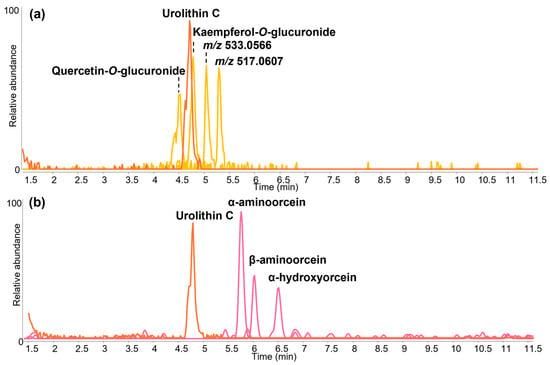
Figure 13.
Extracted ion chromatograms obtained through HPLC-ESI-QToF analysis of samples of (a) yellow and (b) pink fibres from relic wrapping, 1850,1127.1.g. © The Trustees of the British Museum.
The dye analysis of the sample from the pink area revealed molecular markers for the use of orchil (α-aminoorcein, β-aminoorcein and α-hydroxyorcein) [37] and sappanwood (urolithin C) (Figure 13b).
3.5. Textile Fragments 1850,1127.1.b, d, h, j and k
The results of FORS analysis on textile fragments 1850,1127.1.b, d, h, j and k are summarised in the Supplementary Information (Table S1). It should be noted that this group consists of nine fragments in total since 1850,1127.1.d is a group of two fragments (also labelled Di and Dii), 1850,1127.1.h is a group of three fragments (two fragments labelled Hi and third labelled Hii) and 1850,1127.1.k is a group of two fragments (Ki and Kii). Only four of these gave apparent absorption spectra with features that were indicative of the colourants present. 1850,1127.1.b and 1850,1127.1.h (one of the pair of fragments labelled Hi), both dark pink in colour, gave spectra with apparent absorption maxima at c. 520 and c. 560 nm, suggesting the presence of insect-based anthraquinone dyes [38,39]. 1850,1127.1.j, a pale salmon pink fragment, yielded an apparent absorption spectrum with a maximum at c. 520 nm, consistent with the presence of safflower [18,40]. A blue thread, part of the 1850,1127.1.k group, labelled Kiii and thought to be contemporary with the reliquary head, gave an apparent absorption maximum at c. 660 nm, consistent with the presence of an indigoid dye [17].
4. Discussion
The results obtained confirm previous findings whilst contributing new data, affording a better contextualisation of the origins of these objects. In general, many of the original attributions on the origin and dating of the textiles made by Hero Granger-Taylor in her 1989 examination of these [13] were supported by the results of the dye analysis carried out in this investigation. The latter also confirmed some of the somewhat tentative findings of the early attempts at dye analysis [14,15].
In all cases, the use of silk was confirmed, in line with the idea that these precious textiles were purposefully chosen for reuse in a sacred setting. This relates to the wider medieval European practice of using silk, usually as fragments cut from what were once larger textiles, as a suitably luxurious way of containing holy relics [41]. The status of such relics necessitated reliquaries and wrappings, which reflected the importance of their contents. Beyond its aesthetic and economic value, silk held symbolic meaning [42]. In her study of the mobility of textiles within and around medieval Eurasia, Williams acknowledges this aspect, writing, ‘Because of their innate value, many imported silks were used as wrappings for relics, suggesting a spiritual appreciation for these textiles throughout Europe’ [43]. Additionally, the dye analysis results were able to point to the possible geographic origins of the textile fragments. By expanding the geographic reach of these silks, it allows a new perspective on the St Eustace head reliquary. In exhibition catalogues and scholarship, the reliquary is situated as a Romanesque object from the Upper Rhineland, possibly Basel. However, when its contents are also considered, the reliquary instead becomes a mixed media artefact, representing a wide variety of places and periods. It raises further questions about the reliquary and the access to and use of silks in medieval Basel. Did these silks reach Basel with the relics? Or were the textiles already present in the cathedral?
The use of a mixture of a yellow flavonoid dye and sappanwood in 1850,1127.1.a suggests that the original textile was once much brighter than its current faded appearance. As the dating of the textile is suggested as 7th century, the use of sappanwood also points towards an Asian production source. Sappanwood is native to South and Southeast Asia [44], and there is evidence of its use in Asian textiles since at least the 3rd century CE [45]. Some examples of the use of sappanwood are also available from Late Antique textiles from Egypt or the Eastern Mediterranean area dating approximately from the 6th to the 10th century CE [46]. By contrast, sappanwood appears to have been introduced into European dyeing practices in Medieval times (10th–13th century CE) [44]. Textile fragment 1850,1127.1.a also has some parallels with other resist-patterned silk textiles found in excavations in Xinjiang and other Northwestern Asian sites [46], making a Central Asian or Chinese production particularly likely.
The multiband images also suggest that the white dots remained undyed. This supports the interpretation that the resist was firstly put on as dots, and the dye applied once. Then, the resist would have been applied a second time as the spear-head shapes, and dyed again, thus justifying the lighter shade of the spear-head areas. The dye may have been the same for both dyeing steps. However, as the sample taken for analysis contained both colours, it is impossible to tell if yellow and red dyes were used separately for each stage or a mixture of both was used in sequential resist dyeing steps.
Comparable white silk textiles with brocaded or weft patterned designs in white or coloured silks to 1850,1127.1.c have survived in a number of church contexts, notably in Rome (Sancta Sanctorum), Ravenna, Saint-Maurice ([47] no. 134, pp. 164–166), Chur, Taben-an-der-Saar, Utrecht and Durham. Where these can be dated, they belong to the 8th or 9th century and are likely of Italian production. The detection of a mixture of kermes and cochineal is consistent with a Mediterranean production source at this period [44,48]. Some comparative examples of the use of this dye mixture were observed in the analyses of some Spanish and Byzantine textiles (dating from Late Antiquity to early 17th century) from the V&A’s collection [49].
For 1850,1127.1.f, the use of madder (Rubia tinctorum) and weld (Reseda luteola) in both the yellow and green areas, in the latter case in combination with indigo, was found. These dyes and their combination are consistent with a Mediterranean production with a wide-ranging period of use [44,48]. Although weft-faced compound twill remained the most common pattern weave for silk textiles from about the 6th to the 13th century [50], and the well-preserved, vibrant quality of the colours of this fragment probably suggest a date for the textile that is not much earlier than that for the reliquary, more recent discussions place it at the later end of this time frame.
Orchil was found to be present in a sample of pink/red fibres from 1850,1127.1.g, together with sappanwood and an incompletely identified yellow dye. As discussed, sappanwood is consistent with the ca. 7th century Central Asian origin suggested [18,21,25], but orchil has not been typically observed in Asian textiles. Orchil is a general term that includes various lichen-derived dyes produced upon ammoniacal fermentation of various species of lichens [44]. Among the most studied are the lichens of the Roccella genus, mostly distributed in the European and Mediterranean areas. Nevertheless, Roccella montagnei is a species of lichen reported to be used as source of orchil dye and with a habitat distribution that spans all territories touched by the Indian Ocean [44]. Other species include Ochrolechia, Pertusaria and Lasallia genera. The combination of HPLC analysis and principal component analysis can be exploited to attempt the distinction of the dye source of orchil, although the main colouring components are the same for all lichens [37]. As only a few orchil molecular markers were detected in the sample from 1850,1127.1.g, this approach was not possible, and the exact lichen source cannot be identified. Although orchil has mostly been identified in textiles from European contexts [51,52,53,54], its use in other areas, including various parts of Asia, cannot be excluded, as sources of orchil have been historically available.
The yellow dye detected in 1850,1127.1.g contains flavonoid glucuronides, which are not reported in typical European or Mediterranean yellow dyes, but rather in some plants from the Middle Eastern and Central Asian areas [36]. Additionally, the UVL and VIVL images reveal some luminescence from a circular feature at the front of the textile and in two defined bands at the back of the textile. Although samples from these areas could not be taken, such characteristic luminescence is typical of safflower red (Carthamus tinctorius) [18,40], which is a common dye in Asian textiles from this period.
Combining these observations with the style and technical production of this textile, which features a Central Asian paired bird-in-roundel motif with close parallels to weft-faced compound twills excavated in Central Asian and western China (Kothan, Dunhuang, etc), a production from these areas appears a strong possibility. For example, silk fragments featuring paired confronted birds in roundels (ducks and chicks) have been found in burials in Astana, China [55,56]. Consequently, this might represent the first identification of the orchil dye in this context as well as the first indication of its use in a mixture with sappanwood and an unknown yellow dye. It also showcases the need for further research to establish stronger parallels and integrated various research strands in order to refine the production origin or archaeological and historical textiles.
Although FORS analysis of the textile fragments 1850,1127.1.b, d, h, j and k only provided indications of the use of insect-red anthraquinone dyes in textiles 1850,1127.1.b and 1850,1127.1.h (Hi), safflower in 1850,1127.1.j and an indigoid dye in 1850,1127.1.k (Kiii), obtaining good quality data from analyses undertaken through the Perspex glass of the textile mounts represents an interesting result in itself. This gives conservators and scientists an even safer option to non-invasively investigate organic dyes in textiles, and potentially other objects, without removing them from their mounts, providing that the material in the mount cover does not interfere with the analysis, as is the case for Perspex glass.
5. Conclusions
This study revisits and expands upon previous analyses of the textile wrappings found inside the early 13th-century St Eustace head reliquary in the British Museum collection. A powerful combination of scientific techniques, including multiband imaging, FORS, SEM-EDX and HPLC-MS, revealed the dye palette of four of the fragments that could be thoroughly investigated. The other fragments were analysed non-invasively using FORS, while still under their Perspex glass mounts. Despite this, indications for the presence of insect-derived red anthraquinone dyes, safflower (Carthamus tinctorius) and an indigoid dye were obtained from some of these fragments, showcasing the usefulness of this approach when textiles cannot be removed from their conservation mounts.
The confirmation of silk as the primary fibre used in these textiles, alongside dye identification results, supports the varied origins of these textiles, which span from the Mediterranean area to Central Asia. The importance of combining technical textile analysis with chemical data emerges as a powerful tool to elaborate on textile origin questions. However, uncertainties remain regarding the precise identification of some dyes and their historical use, highlighting the need for wider comparative studies to strengthen our ability to contextualise these results.
Nevertheless, these insights offer new perspectives on the St Eustace head reliquary, strengthening its interpretation as a composite and multi-period artefact, which represents a wide variety of geographic and cultural inputs. Further questions are raised about the circulation and reuse of silk textiles in medieval Basel and beyond, as well as their re-use in religious contexts, calling for additional research to be undertaken. Multiple medieval silks are known of from Basel Minster but are now divided across various locations. The remains of silk vestments from graves in the Minster are preserved in the Historisches Museum Basel [57], and further relic wrappings from the Treasury’s reliquaries are in the Benediktinerkloster Mariastein, where the relics that were removed from their containers were transferred in 1834 ([47] nos. 118–119, pp. 147–150), [58,59]. It is not known which reliquaries the latter wrappings came from, but the scientific analysis presented here on the St Eustace textile fragments could be a point of comparison if the Mariastein textiles were to be analysed, raising the potential for more examples from similar sources to be identified with similar dye results. This would situate the St Eustace textiles within a wider material context.
Ultimately, the fragility of the St Eustace textiles means that their permanent display in the British Museum alongside the reliquary bust and wooden core is unlikely, but the results of this analysis and their recent display in ‘Silk Roads’ can have an important impact on the future interpretation of the assemblage to the public, adding a new dimension to its story and opening up the opportunity to include scientific analysis in the gallery. In doing so, the complexities of mixed media ensembles from the Middle Ages, which combine materials and objects from different times and places, can be further revealed.
Supplementary Materials
The following supporting information can be downloaded at: https://www.mdpi.com/article/10.3390/heritage8060206/s1, Table S1: Description of textiles 1850,1127.1.a–k found inside the St Eustace head reliquary, a summary of previous analyses and additional FORS measurements carried out for this work. In bold those discussed in this work. Figure S1: Tandem mass spectra obtained in negative ionisation mode of (a) kaempferol-O-glucuronide; (b) quercetin-O-glucuronide; (c) [M-H]− = 517.0624 m/z; (d) [M-H]− = 533.0573 m/z.
Author Contributions
Conceptualization, J.D., D.T. and N.S.; methodology, J.D. and D.T.; formal analysis, J.D., D.T. and C.R.C.; investigation, J.D. and D.T.; resources, N.S.; data curation, J.D. and D.T.; writing—original draft preparation, J.D.; writing—review and editing, J.D., D.T., C.R.C. and N.S. All authors have read and agreed to the published version of the manuscript.
Funding
This research received no external funding.
Data Availability Statement
The raw data presented in this study are available on request from the corresponding author.
Acknowledgments
Many thanks are due to Hero Granger-Taylor, Anna Harrison, Elisabeth R. O’Connell and Vincent Daniels for helpful discussions.
Conflicts of Interest
The authors declare no conflicts of interest.
References
- Falk, B. Bildnisreliquiare: Zur Entstehung und Entwicklung der metallenen Kopf-, Büsten-und Halbfigurenreliquiare im Mittelalter. Aachen. Kunstbl. 1991–1993, 59, 99–238, at no. 52, pp. 206–209. [Google Scholar] [CrossRef]
- Burckhardt, R.F. Die Kunstdenkmäler des Kantons Basel-Stadt. Bd 2. In Der Basler Münsterschatz; Verlag E. Birkhäuser & Cie: Basel, Switzerland, 1933; no. 5; pp. 62–68. [Google Scholar]
- Husband, T. 9. Reliquary Head of Saint Eustace. In The Treasury of Basel Cathedral; Husband, T., Chapuis, J., Eds.; Metropolitan Museum of Art: New York, NY, USA, 2001; pp. 54–55. [Google Scholar]
- Robinson, J. Masterpieces of Medieval Art; British Museum Press: London, UK, 2008; pp. 74–75. [Google Scholar]
- Speakman, N. 104. Reliquary Head of St. Eustace. In Treasures of Heaven: Saints, Relics and Devotion in Medieval Europe; Bagnoli, M., Klein, H.A., Mann, C.G., Robinson, J., Eds.; British Museum Press: London, UK, 2011; p. 191. [Google Scholar]
- Cherry, J. 13. Kopfreliquiar des hl. Eustachius. In Der Basler Münsterschatz; Meles, B., Ed.; Christoph Merian Verlag: Basel, Switzerland, 2001; pp. 60–64. [Google Scholar]
- Joyner, L.; Freestone, I.; Robinson, J. Crowning glory: The identification of gems on the head reliquary of St Eustace from the Basle Cathedral Treasury. J. Gemmol. 2006, 30, 169–182. [Google Scholar] [CrossRef]
- Cartwright, C.R.; Joyner, L.; Ambers, J.C. Report on the 13th Century Silver Gilt Head Reliquary from Basle Cathedral; Unpublished British Museum DSR Project 0857 Report; The British Museum: London, UK, 1999. [Google Scholar]
- Folda, J. Crusader Art in the Holy Land, from the Third Crusade to the Fall of Acre; Cambridge University Press: Cambridge, UK, 2005; pp. 69–71. [Google Scholar]
- Gunther, P. The Capture of Constantinople: The Hystoria Constantinopolitana of Gunther of Pairis; Adams, A., Ed. and Translator; University of Pennsylvania Press: Philadelphia, PA, USA, 1997; pp. 123–124. [Google Scholar]
- Novelties in the British Museum. The Daily News, 22 April 1851; p. 3.
- Muthesius, A.M. Eastern Silks in Western Shrines and Treasuries Before 1200; Courtauld Institute of Art (University of London): London, UK, 1980; pp. 309–310. [Google Scholar]
- Granger-Taylor, H. Textile Fragments From the Basel Reliquary Head, British Museum (MLA 50 11-27 1); Unpublished British Museum Report; The British Museum: London, UK, 1989. [Google Scholar]
- Green, L.R. Analysis of Dyes From Silk Textile Fragments Found with the Basel Reliquary Head (MLA 50 11-27 1); Unpublished British Museum Conservation Research Report, LR1990-21; The British Museum: London, UK, 1990. [Google Scholar]
- Daniels, V.D. Analysis of Dyes on Eight Textile Samples; Unpublished British Museum Conservation Research Report, LR1991-19; The British Museum: London, UK, 1991. [Google Scholar]
- Brunning, S.; Luk, Y.P.; O’Connell, E.R.; Williams, T. Silk Roads; The British Museum: London, UK, 2024; pp. 256–257. [Google Scholar]
- Dyer, J.; Tamburini, D.; O’Connell, E.R.; Harrison, A. A multispectral imaging approach integrated into the study of Late Antique textiles from Egypt. PLoS ONE 2018, 13, e0204699. [Google Scholar] [CrossRef] [PubMed]
- Tamburini, D.; Dyer, J. Fibre optic reflectance spectroscopy and multispectral imaging for the non-invasive investigation of Asian colourants in Chinese textiles from Dunhuang (7th–10th century AD). Dye. Pigment. 2019, 162, 494–511. [Google Scholar] [CrossRef]
- Tamburini, D.; Dyer, J.; Cartwright, C.; Green, A. Changes in the production materials of Burmese textiles in the nineteenth century—Dyes, mordants and fibres of Karen garments from the British Museum’s collection. Herit. Sci. 2023, 11, 150–181. [Google Scholar] [CrossRef]
- Dyer, J.; Verri, G.; Cupitt, J. Multispectral Imaging in Reflectance and Photo-Induced Luminescence Modes: A User Manual; 2013. Available online: https://www.researchgate.net/publication/267266175_Multispectral_Imaging_in_Reflectance_and_Photo-induced_Luminescence_modes_A_User_Manual (accessed on 28 May 2025).
- Tamburini, D.; Cartwright, C.R.; Pullan, M.; Vickers, H. An investigation of the dye palette in Chinese silk embroidery from Dunhuang (Tang dynasty). Archaeol. Anthropol. Sci. 2019, 11, 1221–1239. [Google Scholar] [CrossRef]
- Ilvessalo-Pfäffli, M.-S. Fiber Atlas: Identification of Papermaking Fibers; Springer Science & Business Media: Berlin/Heidelberg, Germany, 1995. [Google Scholar]
- Cartwright, C.R.; Duffy, C.; Wang, H. Microscopical examination of fibres used in Ming dynasty paper money. Br. Mus. Tech. Res. Bull. 2014, 8, 105–116. [Google Scholar]
- Rast-Eicher, A. Fibres: Microscopy of Archaeological Textiles and Furs; Archaeolingua Alapítvány: Budapest, Hungary, 2016. [Google Scholar]
- Tamburini, D. Investigating Asian colourants in Chinese textiles from Dunhuang (7th–10th century AD) by high performance liquid chromatography tandem mass spectrometry—Towards the creation of a mass spectra database. Dye. Pigment. 2019, 163, 454–474. [Google Scholar] [CrossRef]
- van der Klift, E.; Villela, A.; Derksen, G.C.H.; Lankhorst, P.P.; van Beek, T.A. Microextraction of Reseda luteola-Dyed Wool and Qualitative Analysis of Its Flavones by UHPLC-UV, NMR and MS. Molecules 2021, 26, 3787. [Google Scholar] [CrossRef]
- Marques, R.; Sousa, M.M.; Oliveira, M.C.; Melo, M.J. Characterization of weld (Reseda luteola L.) and spurge flax (Daphne gnidium L.) by high-performance liquid chromatography–diode array detection–mass spectrometry in Arraiolos historical textiles. J. Chromatogr. A 2009, 1216, 1395–1402. [Google Scholar] [CrossRef]
- Zhang, X.; Good, I.; Laursen, R. Characterization of dyestuffs in ancient textiles from Xinjiang. J. Archaeol. Sci. 2008, 35, 1095–1103. [Google Scholar] [CrossRef]
- Liu, J.; Li, W.; Kang, X.; Zhao, F.; He, M.; She, Y.; Zhou, Y. Profiling by HPLC-DAD-MSD reveals a 2500-year history of the use of natural dyes in Northwest China. Dye. Pigment. 2021, 187, 109143. [Google Scholar] [CrossRef]
- Doherty, B.; Degano, I.; Romani, A.; Higgitt, C.; Peggie, D.; Colombini, M.P.; Miliani, C. Identifying Brazilwood’s Marker Component, Urolithin C, in Historical Textiles by Surface-Enhanced Raman Spectroscopy. Heritage 2021, 4, 1415–1428. [Google Scholar] [CrossRef]
- Wouters, J.; Verhecken, A. The coccid insect dyes: Hplc and computerized diode-array analysis of dyed yarns. Stud. Conserv. 1989, 34, 189–200. [Google Scholar] [CrossRef]
- Mantzouris, D.; Karapanagiotis, I. Armenian cochineal (Porphyrophora hamelii) and purpurin-rich madder in ancient polychromy. Color. Technol. 2015, 131, 370–373. [Google Scholar] [CrossRef]
- Serrano, A.; van den Doel, A.; van Bommel, M.; Hallett, J.; Joosten, I.; van den Berg, K.J. Investigation of crimson-dyed fibres for a new approach on the characterization of cochineal and kermes dyes in historical textiles. Anal. Chim. Acta 2015, 897, 116–127. [Google Scholar] [CrossRef]
- Mouri, C.; Laursen, R. Identification of anthraquinone markers for distinguishing Rubia species in madder-dyed textiles by HPLC. Microchim. Acta 2012, 179, 105–113. [Google Scholar] [CrossRef]
- Aceto, M.; Calà, E.; Agostino, A.; Fenoglio, G.; Gulmini, M.; Idone, A.; Porter, C.; Hofmann, C.; Rabitsch, S.; Denoël, C.; et al. Mythic dyes or mythic colour? New insight into the use of purple dyes on codices. Spectrochim. Acta Part A Mol. Biomol. Spectrosc. 2019, 215, 133–141. [Google Scholar] [CrossRef]
- Mouri, C.; Mozaffarian, V.; Zhang, X.; Laursen, R. Characterization of flavonols in plants used for textile dyeing and the significance of flavonol conjugates. Dye. Pigment. 2014, 100, 135–141. [Google Scholar] [CrossRef]
- Calà, E.; Benzi, M.; Gosetti, F.; Zanin, A.; Gulmini, M.; Idone, A.; Serafini, I.; Ciccola, A.; Curini, R.; Whitworth, I.; et al. Towards the identification of the lichen species in historical orchil dyes by HPLC-MS/MS. Microchem. J. 2019, 150, 104140. [Google Scholar] [CrossRef]
- Clementi, C.; Doherty, B.; Gentili, P.L.; Miliani, C.; Romani, A.; Brunetti, B.G.; Sgamellotti, A. Vibrational and electronic properties of painting lakes. Appl. Phys. A 2008, 92, 25–33. [Google Scholar] [CrossRef]
- Gulmini, M.; Idone, A.; Diana, E.; Gastaldi, D.; Vaudan, D.; Aceto, M. Identification of dyestuffs in historical textiles: Strong and weak points of a non-invasive approach. Dye. Pigment. 2013, 98, 136–145. [Google Scholar] [CrossRef]
- Tamburini, D.; Dyer, J.; Vandenbeusch, M.; Borla, M.; Angelici, D.; Aceto, M.; Oliva, C.; Facchetti, F.; Aicardi, S.; Davit, P.; et al. A multi-scalar investigation of the colouring materials used in textile wrappings of Egyptian votive animal mummies. Herit. Sci. 2021, 9, 106. [Google Scholar] [CrossRef]
- Bagnoli, M. Dressing the Relics: Some Thoughts on the Custom of Relic Wrapping in Medieval Christianity. In Matter of Faith: An Interdisciplinary Study of Relics and Relic Veneration in the Medieval Period; Robinson, J., De Beer, L., Harnden, A., Eds.; The British Museum: London, UK, 2014; pp. 100–109. [Google Scholar]
- Fleming, R. Acquiring, Flaunting and Destroying Silk in late Anglo-Saxon England. Early Mediev. Eur. 2007, 15, 127–158. [Google Scholar] [CrossRef]
- Williams, E.D. The Mobility of Fabric: Textiles in and around Medieval Eurasia. In Bringing the Holy Land Home: The Crusades, Chertsey Abbey, and the Reconstruction of a Medieval Masterpiece; Luyster, A., Ed.; Harvey Miller Publishers: London, UK, 2023; pp. 177–200, at p. 191. [Google Scholar]
- Cardon, D. Natural Dyes: Sources, Tradition, Technology and Science; Archetype: London, UK, 2007. [Google Scholar]
- de Graaff, J.H.H.; Roelofs, W.G.T.; van Bommel, M.R. The Colourful Past: Origins, Chemistry and Identification of Natural Dyestuffs; Abegg-Stiftung: Riggisberg, Switzerland, 2004. [Google Scholar]
- Keijzer, R.H.; Bommel, M.R.; Joosten, I.; Bogensperger, I. Late Antique Textiles from the Papyrus Collection of the Austrian National Library: Scientific Investigation of Fibres, Dyes and Dyeing Techniques; De Gruyter: Berlin, Germany, 2024. [Google Scholar]
- Schmedding, B. Mittelalterliche Textilien in Kirchen und Klöstern der Schweiz: Katalog; Stämpfli: Bern, Switzerland, 1978; no. 134, pp. 164–166; nos. 118–119, pp. 147–150. [Google Scholar]
- Petroviciu, I.; Nabais, P.; Melo, M. Red Dyes from West to East in Medieval Europe: From Portuguese Manuscript Illuminations to Romanian Textiles. In Textile Crossroads: Exploring European Clothing, Identity, and Culture Across Millennia. Anthology of COST Action “CA 19131—EuroWeb”; Droß-Krüpe, K., Quillien, L., Sarri, K., Eds.; Zea Books: Lincoln, NE, USA, 2024. [Google Scholar]
- Cabrera Lafuente, A.; Tamburini, D.; Dyer, J. Developing a protocol using FORS for the selection and study of historical textiles in the Victoria and Albert Museum. In Dyes in History and Archaeology 36 (DHA 36); Hampton Court Palace: England, UK, 2017. [Google Scholar]
- Miller, L.E.; Lafuente, A.C. Silk: Fiber, Fabric, and Fashion; WW Norton: New York, NY, USA, 2021. [Google Scholar]
- Witkowski, B.; Ganeczko, M.; Hryszko, H.; Stachurska, M.; Gierczak, T.; Biesaga, M. Identification of orcein and selected natural dyes in 14th and 15th century liturgical paraments with high-performance liquid chromatography coupled to the electrospray ionization tandem mass spectrometry (HPLC-ESI/MS/MS). Microchem. J. 2017, 133, 370–379. [Google Scholar] [CrossRef]
- Vanden Berghe, I.; Gleba, M.; Mannering, U. Towards the identification of dyestuffs in Early Iron Age Scandinavian peat bog textiles. J. Archaeol. Sci. 2009, 36, 1910–1921. [Google Scholar] [CrossRef]
- Joosten, I.; van Bommel, M.R.; Keijzer, R.H.-d.; Reschreiter, H. Micro Analysis on Hallstatt Textiles: Colour and Condition. Microchim. Acta 2006, 155, 169–174. [Google Scholar] [CrossRef]
- Claisse, P.; Marembert, C.; Galluzzi, F.; Chapoulie, R.; Dallel, M.; Mounier, A. Ephemeral Orchil in the Lady and the Unicorn Tapestry: Recipe, Experimentation, and Characterisation. Heritage 2024, 7, 3455–3469. [Google Scholar] [CrossRef]
- Bivar, A.D.H. Sasanian Iconography on Textiles and Seals. In Central Asian Textiles and Their Contexts in the Early Middle Ages; Schorta, R., Ed.; Abegg-Stiftung: Riggisberg, Switzerland, 2006; pp. 9–21, at pp. 16–17. [Google Scholar]
- Kuhn, D. Medieval Chinese Silk Fabrics: Technical Versatility and Puzzling Terminology. In Oriental Silks in Medieval Europe; von Fircks, J., Schorta, R., Eds.; Abegg-Stiftung: Riggisberg, Switzerland, 2016; pp. 12–33, at p. 23. [Google Scholar]
- Meier, H.-R.; Schwarz, P.-A.; Ochsner, C. Die Grabfunde des 12. bis 19. Jahrhunderts aus dem Basler Münster: Repräsentation im Tod und kultureller Wandel im Spiegel der materiellen Kultur; Materialhefte zur Archäologie in Basel; Archäologische Bodenforschung des Kantons Basel-Stadt Place: Basel, Switzerland, 2013; Volume 23, pp. 1–392. [Google Scholar] [CrossRef]
- Husband, T. Relics Sacred and Profane. In The Treasury of Basel Cathedral; Husband, T., Chapuis, J., Eds.; Metropolitan Museum of Art: New York, NY, USA, 2001; nos. 45–46; pp. 120–122. [Google Scholar]
- Schorta, R. 3. Goldgemustertes Seidengewebe. 4. Zwei Seidengewebe. In Der Basler Münsterschatz; Meles, B., Ed.; Christoph Merian Verlag: Basel, Switzerland, 2001; pp. 26–29. [Google Scholar]
Disclaimer/Publisher’s Note: The statements, opinions and data contained in all publications are solely those of the individual author(s) and contributor(s) and not of MDPI and/or the editor(s). MDPI and/or the editor(s) disclaim responsibility for any injury to people or property resulting from any ideas, methods, instructions or products referred to in the content. |
© 2025 by the authors. Licensee MDPI, Basel, Switzerland. This article is an open access article distributed under the terms and conditions of the Creative Commons Attribution (CC BY) license (https://creativecommons.org/licenses/by/4.0/).